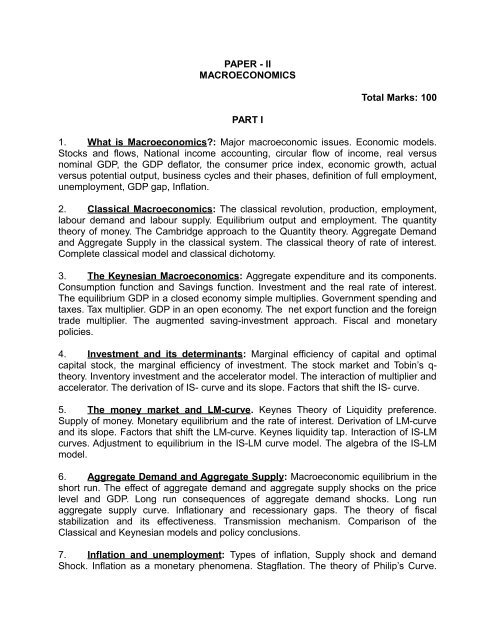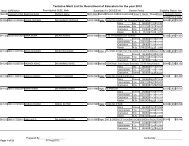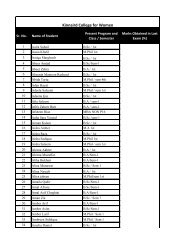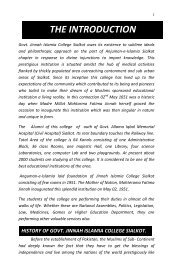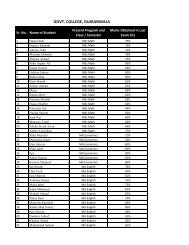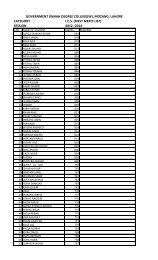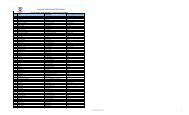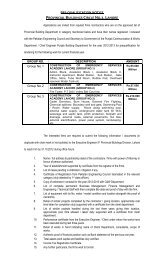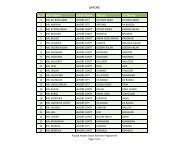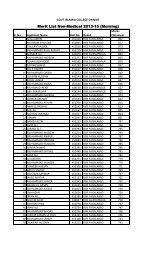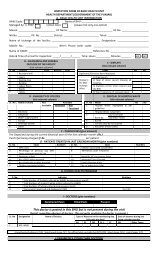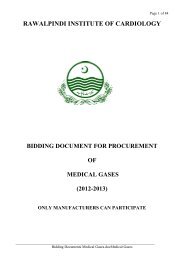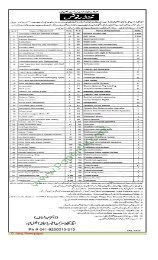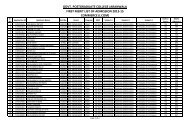syllabus for the subject of veterinary science - Punjab Public Service ...
syllabus for the subject of veterinary science - Punjab Public Service ...
syllabus for the subject of veterinary science - Punjab Public Service ...
Create successful ePaper yourself
Turn your PDF publications into a flip-book with our unique Google optimized e-Paper software.
PAPER - IIMACROECONOMICSTotal Marks: 100PART I1. What is Macroeconomics?: Major macroeconomic issues. Economic models.Stocks and flows, National income accounting, circular flow <strong>of</strong> income, real versusnominal GDP, <strong>the</strong> GDP deflator, <strong>the</strong> consumer price index, economic growth, actualversus potential output, business cycles and <strong>the</strong>ir phases, definition <strong>of</strong> full employment,unemployment, GDP gap, Inflation.2. Classical Macroeconomics: The classical revolution, production, employment,labour demand and labour supply. Equilibrium output and employment. The quantity<strong>the</strong>ory <strong>of</strong> money. The Cambridge approach to <strong>the</strong> Quantity <strong>the</strong>ory. Aggregate Demandand Aggregate Supply in <strong>the</strong> classical system. The classical <strong>the</strong>ory <strong>of</strong> rate <strong>of</strong> interest.Complete classical model and classical dichotomy.3. The Keynesian Macroeconomics: Aggregate expenditure and its components.Consumption function and Savings function. Investment and <strong>the</strong> real rate <strong>of</strong> interest.The equilibrium GDP in a closed economy simple multiplies. Government spending andtaxes. Tax multiplier. GDP in an open economy. The net export function and <strong>the</strong> <strong>for</strong>eigntrade multiplier. The augmented saving-investment approach. Fiscal and monetarypolicies.4. Investment and its determinants: Marginal efficiency <strong>of</strong> capital and optimalcapital stock, <strong>the</strong> marginal efficiency <strong>of</strong> investment. The stock market and Tobin’s q-<strong>the</strong>ory. Inventory investment and <strong>the</strong> accelerator model. The interaction <strong>of</strong> multiplier andaccelerator. The derivation <strong>of</strong> IS- curve and its slope. Factors that shift <strong>the</strong> IS- curve.5. The money market and LM-curve. Keynes Theory <strong>of</strong> Liquidity preference.Supply <strong>of</strong> money. Monetary equilibrium and <strong>the</strong> rate <strong>of</strong> interest. Derivation <strong>of</strong> LM-curveand its slope. Factors that shift <strong>the</strong> LM-curve. Keynes liquidity tap. Interaction <strong>of</strong> IS-LMcurves. Adjustment to equilibrium in <strong>the</strong> IS-LM curve model. The algebra <strong>of</strong> <strong>the</strong> IS-LMmodel.6. Aggregate Demand and Aggregate Supply: Macroeconomic equilibrium in <strong>the</strong>short run. The effect <strong>of</strong> aggregate demand and aggregate supply shocks on <strong>the</strong> pricelevel and GDP. Long run consequences <strong>of</strong> aggregate demand shocks. Long runaggregate supply curve. Inflationary and recessionary gaps. The <strong>the</strong>ory <strong>of</strong> fiscalstabilization and its effectiveness. Transmission mechanism. Comparison <strong>of</strong> <strong>the</strong>Classical and Keynesian models and policy conclusions.7. Inflation and unemployment: Types <strong>of</strong> inflation, Supply shock and demandShock. Inflation as a monetary phenomena. Stagflation. The <strong>the</strong>ory <strong>of</strong> Philip’s Curve.


